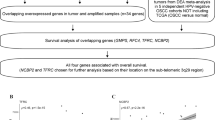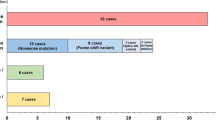Abstract
Gene amplification of chromosomal band 11q13 is observed frequently in oral squamous cell carcinomas (OSCC). Several genes have been identified in the 11q13 amplicon, including FGF3, FGF4, CCND1, EMS1 and TAOS1. Some of these genes show good correlation between gene copy number and gene expression, and are thought to play a role in driving 11q13 amplification. The PPP1CA gene, which encodes the catalytic subunit of serine/threonine protein phosphatase protein phosphatase 1α (PP1α), is also located in 11q13. Protein phosphatase 1α, one of the isoforms of PP1, regulates critical cellular events, such as cell cycle progression, and apoptosis. We sought to explore the possibility that PPP1CA was amplified and overexpressed in OSCC cells. Indeed, some OSCC cell lines had PPP1CA gene amplification, as analysed by fluorescence in situ hybridization. We have also demonstrated that PPP1CA gene copy number is increased in 21% of the OSCC cell lines determined by quantitative microsatellite analysis. PP1α RNA expression determined by quantitative reverse transcription–polymerase chain reaction was significantly higher in OSCC cell lines with 11q13 amplification compared to those without 11q13 amplification (P=0.011). The difference was even more significant between cell lines with at least three copies of the PPP1CA gene and those with less than three copies of the gene (P=0.00045). Relative PP1α protein levels were also significantly associated with PPP1CA gene copy number (P=0.014). Furthermore, knockdown of PP1α and/or cyclin D1 by small interfering RNA suppressed OSCC cell growth, at least in part by modulating pRB phosphorylation, resulting in G0 growth arrest. These data suggest that like the cyclin D1 gene, CCND1, amplification and overexpression of the PP1α gene, PPP1CA, may be involved in OSCC tumorigenesis and/or progression.
This is a preview of subscription content, access via your institution
Access options
Subscribe to this journal
Receive 50 print issues and online access
$259.00 per year
only $5.18 per issue
Buy this article
- Purchase on Springer Link
- Instant access to full article PDF
Prices may be subject to local taxes which are calculated during checkout







Similar content being viewed by others
Abbreviations
- FISH:
-
fluorescence in situ hybridization
- GFP:
-
green fluorescent protein
- OSCC:
-
oral squamous cell carcinoma
- PP1α:
-
protein phosphatase 1α
- QPCR:
-
quantitative PCR
- QuMA:
-
quantitative microsatellite analysis
- siRNA:
-
small interfering RNA
References
Åkervall JA, Jin Y, Wennerberg JP, Zatterstrom UK, Kjellen E, Mertens F et al. (1995). Cancer 76: 853–859.
Alberts AS, Thorburn AM, Shenolikar S, Mumby MC, Feramisco JR . (1993). Proc Natl Acad Sci USA 90: 388–392.
Ayllon V, Cayla X, Garcia A, Roncal F, Fernandez R, Albar JP et al. (2001). J Immunol 166: 7345–7352.
Barker HM, Jones TA, da Cruz e Silva EF, Spurr NK, Sheer D, Cohen PT . (1990). Genomics 7: 159–166.
Ceulemans H, Bollen M . (2004). Physiol Rev 84: 1–39.
Chu EC, Tarnawski AS . (2004). Med Sci Monit 10: RA235–RA241.
Cohen PTW . (2002). J Cell Sci 115: 241–256.
Dickson C, Fantl V, Gillett C, Brookes S, Bartek J, Smith R et al. (1995). Cancer Lett 90: 43–50.
Durfee T, Becherer K, Chen PL, Yeh SH, Yang Y, Kilburn AE et al. (1993). Genes Dev 7: 555–569.
Fu M, Wang C, Li Z, Sakamaki T, Pestell RG . (2004). Endocrinology 145: 5439–5447.
Gaudray P, Szepetowski P, Escot C, Birnbaum D, Theillet C . (1992). Mutat Res 276: 317–328.
Ginzinger DG, Godfrey TE, Nigro J, Moore II DH, Suzuki S, Pallavicini MG et al. (2000). Cancer Res 60: 5405–5409.
Gollin SM . (2001). Head Neck 23: 238–253.
Hsu L-C, White RL . (1998). Proc Natl Acad Sci USA 95: 12983–12988.
Huang X, Gollin SM, Raja S, Godfrey TE . (2002). Proc Natl Acad Sci USA 99: 11369–11374.
Imai Y, Kakinoki Y, Takizawa N, Nakamura K, Shima H, Kikuchi K . (1999). Int J Oncol 14: 121–126.
Janssens V, Goris J, Van Hoof C . (2005). Curr Opin Genet Dev 15: 34–41.
Jin Y, Höglund M, Jin C, Martins C, Wennerberg J, kervall J et al. (1998). Genes Chromosomes Cancer 22: 312–320.
Kohno T, Takakura S, Yamada T, Okamoto A, Tanaka T, Yokota J . (1999). Cancer Res 59: 4170–4174.
Lese CM, Rossie KM, Appel BN, Reddy JK, Johnson JT, Myers EN et al. (1995). Genes Chromosomes Cancer 12: 288–295.
Liu Y, Virshup DM, White RL, Hsu L-C . (2002). Cancer Res 62: 6357–6361.
Motokura T, Bloom T, Kim HG, Jupner H, Ruderman JV, Kronenberg HM et al. (1991). Nature 350: 512–515.
Mumby MC, Walter G . (1993). Physiol Rev 73: 673–699.
Park NH, Min BM, Li SL, Huang MZ, Cherick HM, Doniger J . (1991). Carcinogenesis 12: 1627–1631.
Reshmi SC, Saunders WS, Kudla DM, Ragin CR, Gollin SM . (2004). Genes Chromosomes Cancer 41: 38–46.
Saadat M, Mizuno Y, Takizawa N, Kakinoki Y, Rikuchi R . (1995). Cancer Lett 94: 165–170.
Savelyeva L, Schwab M . (2001). Cancer Lett 167: 115–123.
Scholzen T, Gerdes J . (2000). J Cell Physiol 182: 311–322.
Schuuring E . (1995). Gene 159: 83–96.
Schwab M . (1998). BioEssays 20: 473–479.
Shenolikar S . (1994). Annu Rev 10: 55–86.
Shuster MI, Han L, Le Beau MM, Davis E, Sawicki M, Lese CM et al. (2000). Genes Chromosomes Cancer 28: 153–163.
Sogawa K, Masaki T, Miyauchi A, Sugita A, Kito K, Ueda N et al. (1997). Cancer Lett 112: 263–268.
Wang MB, Billings KR, Venkatesan N, Hall FL, Srivatsan ES . (1998). Otolaryngol Head Neck Surg 119: 593–599.
Wang SJ, Mintz LE, Natarajan V, Lee NJ, Srivatsan ES, Wang MB . (2001). Otolaryngol Head Neck Surg 124: 656–662.
Acknowledgements
We thank Dale Lewis, Suman Barua, Linda Klei, Dr Rahul Parikh and Dr Zhisheng Yu for technical support. This work was supported by funds from the Jennie K Scaife Ovarian Cancer Center (to LCH), NIH Grants R01 CA111436 (to LCH) and R01 DE14729 (to SMG). The molecular cytogenetic analyses were carried out in the UPCI Cytogenetics Facility supported in part by NIH Grant P30 CA47904 to Dr RB Herberman.
Author information
Authors and Affiliations
Corresponding author
Rights and permissions
About this article
Cite this article
Hsu, LC., Huang, X., Seasholtz, S. et al. Gene amplification and overexpression of protein phosphatase 1α in oral squamous cell carcinoma cell lines. Oncogene 25, 5517–5526 (2006). https://doi.org/10.1038/sj.onc.1209563
Received:
Revised:
Accepted:
Published:
Issue Date:
DOI: https://doi.org/10.1038/sj.onc.1209563
Keywords
This article is cited by
-
Identification of intracellular cavin target proteins reveals cavin-PP1alpha interactions regulate apoptosis
Nature Communications (2019)
-
Nuclear Protein Phosphatase 1 α (PP1A) Expression is Associated with Poor Prognosis in p53 Expressing Glioblastomas
Pathology & Oncology Research (2016)
-
Genomic analysis of host – Peste des petits ruminants vaccine viral transcriptome uncovers transcription factors modulating immune regulatory pathways
Veterinary Research (2015)
-
Tumour-suppressive microRNA-874 contributes to cell proliferation through targeting of histone deacetylase 1 in head and neck squamous cell carcinoma
British Journal of Cancer (2013)
-
Tumour suppressive microRNA-874 regulates novel cancer networks in maxillary sinus squamous cell carcinoma
British Journal of Cancer (2011)



